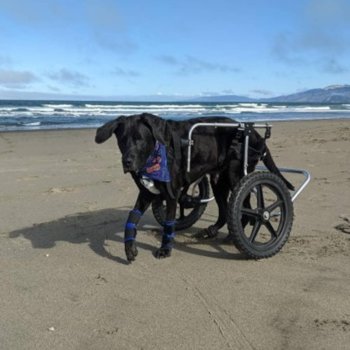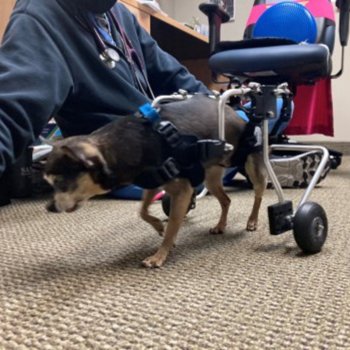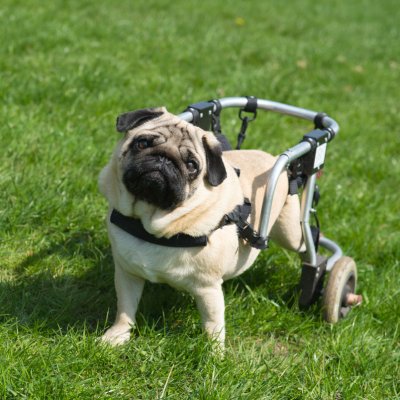We all know the importance of assistive devices in providing modified or improved independence to our patients. Analyzing function and making modifications to maximize mobility and efficiency is one of the primary roles of a physical therapist. This holds true in the world of physical therapy for animals as well. As physical therapists crossing over into the collaborative world of veterinary rehabilitation, we bring our expertise and creativity to help creatures of all sizes and species.
Dogs are living longer and fuller lives now, more than ever before. A longer life span often comes with the additional challenges of impaired strength, mobility, and comfort due to conditions such as osteoarthritis (OA), intervertebral disc disease (IVDD), hip and elbow dysplasia, cancer, and generalized weakness due to aging.
We want our pets to thrive into their golden years and be able to do all the things they love. One thing pet guardians often express regret and sadness over is the declining opportunity to include their pets in the adventures they cherish together. There are many things that can be considered to improve mobility and comfort, one of which being carts - better known as wheelchairs. Let’s stick with the term cart, as we want to think of them as a mobility device, not a passive device.
When you think of a dog using a cart, an image of a dog with rear limb paralysis usually comes to mind - perhaps a Dachshund or French Bulldog? Thinking of carts as an assistive device expands the possibilities of their usefulness. An assistive device is any device helping to improve independence performing activities of daily living. For dogs, their primary activity of daily living is mobility. Depending on the dog’s level of function, a cart can serve the same purpose as a cane or walker that a person might use if they need some help but can walk; or more like a wheelchair if there is a higher level of mobility impairment.
“Thinking of carts as an assistive device expands
the possibilities of their usefulness.”
It is a common misconception that wheels are a last resort, even in the veterinary community. Think of a person who has had an orthopedic surgery, or any major surgery, really…do we ask them to struggle to walk and do the best they can without anything at all? Usually not! Physical therapy is generally prescribed, and the individual is taught to use an assistive device that helps them achieve modified independence, as they work their way back to full independence. If that is not the end goal, we support them with the devices they need to maximize functional mobility and achieve modified independence.
Now think of a dog who needs support to walk, for whatever reason that might be. It could be an older dog who is slowing down and having a harder time going for their daily walks, or even a younger dog who is recovering from an injury or surgery. Along with a proper harness, wheels may be just the ticket to help build strength and recover or may help to improve mobility. When fitted and used properly, wheels can speed recovery and even help older dogs get stronger, so when they are not using the wheels, their mobility is improved. Wheels may also help your own health as a caregiver and save your own body!
Let’s take a look at a couple examples of cases where wheels might be helpful, aside from the more obvious cases where a pet is dealing with paralysis.
Image 1. Oreo at Ocean Beach, San Francisco. Doggon’ Wheels cart and TheraPaw carpe-flex sport wraps.

Oreo is a 13 year-old hound mix who was slowing down on his walks. He has had some physical challenges that required surgery in the past and physical rehabilitation, but he’s overall healthy. His mom reports he is slower and not going as far on his usual walks. He goes to physical rehabilitation weekly to stay in shape. A rear wheel cart was introduced just for longer walks initially. Oreo was still bearing full weight on the hind limbs, but a little weight was relieved from his front legs, so he was more balanced. He was able to return to his normal longer walks and did not seem as tired or stiff afterwards. As he got older, he used the carts for all walks eventually, but was still able to walk independently without the wheels. He was able to go for walks on the beach, whereas it was getting to be too difficult for him without the wheels.
Image 2. Tikka at The Whole Pet Vet in Los Gatos, CA. Doggon’ Wheels cart

Tikka is a senior chihuahua who has a history of medial patellar luxation and cruciate tears in both stifles. She is having a harder time walking on her own and is not able to go much further than walking around the house. Sometimes her legs give out. A rear wheel cart was recommended by her physical therapist. Tikka was able to walk with taller posture and go further, going out for short walks to help her build strength in addition to her rehab sessions.
There are several companies out there to consider. A certified physical therapist or veterinarian can help determine if wheels might help improve your pet’s mobility and quality of life, and help you choose which might be best for the needs of you and your pup. Wheels may help your pup keep doing the activities they love and may be useful earlier than you might think.
As physical therapists, we provide a unique skill set in movement and gait analysis, knowledge of assistive devices and their function, and expertise in breaking down tasks and instructing them to help get our patients back to living their fullest lives. In collaboration with all the members of the veterinary community, we can together provide a well-rounded team to help animals thrive.
If you are interested in animal physical therapy, check out our special interest group for more information at https://www.orthopt.org/content/special-interest-groups/animal-physical-therapy.
The author declares she owns Doggon’ Wheels.
Author Bio:
Dr. Jenny Moe, PT, MS, DPT, CCRT, APT has 20 years of experience as a physical therapist, the last 14 focused fully on animal rehabilitation. She has worked in various settings from specialty veterinary medicine clinics to her own clinic in Tahoe, and now focuses on offering manual therapy in the home setting. Dr. Moe took over one of the longest running dog wheelchair companies in 2021, her favorite company Doggon’ Wheels, now making custom carts for animals in San Francisco. She has a passion for assistive devices, bracing, senior dogs, and cats. She can usually be found at the beach with her cattle dogs or training for triathlons around the Bay Area. Dr. Moe can be contacted through Moe Love Myofascial Release or Doggon’ Wheels, LLC.

